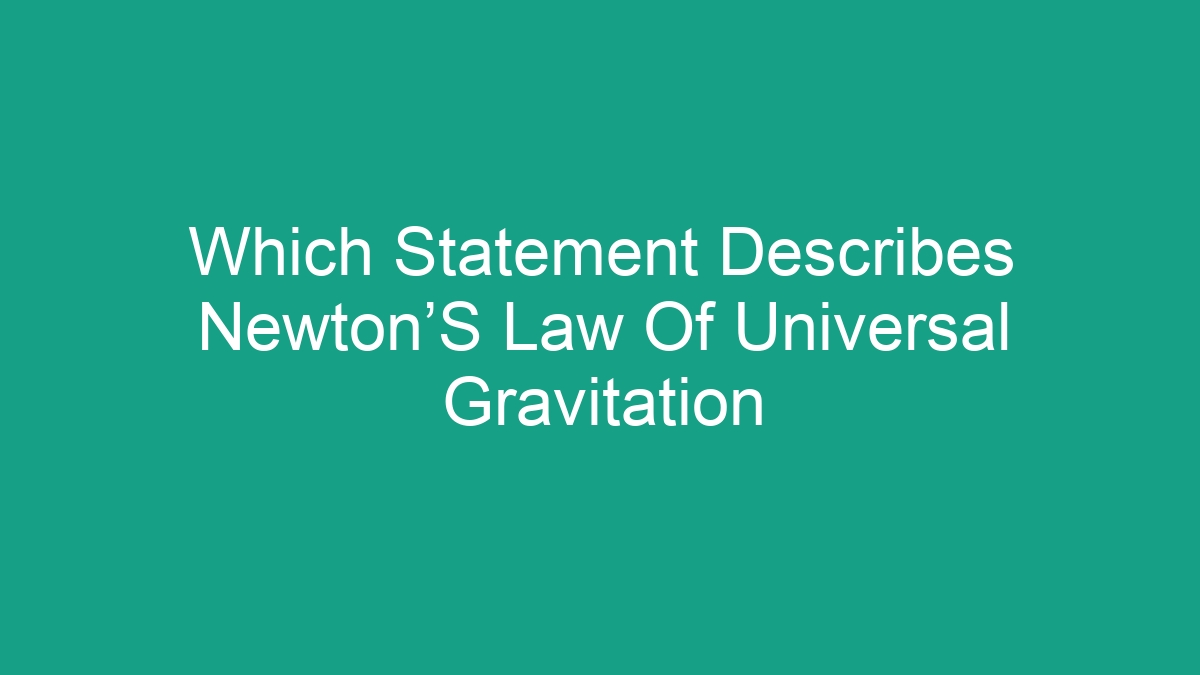
Introduction to NewtonʼS Law Of Universal Gravitation
Newtonʼs Law of Universal Gravitation is a fundamental principle in physics that describes the force of gravity between two objects. This law was formulated by Sir Isaac Newton in the 17th century and has since become the cornerstone of classical physics. Newtonʼs Law of Universal Gravitation is a simple yet powerful equation that can be used to explain the motion of celestial bodies, the tides, and a wide range of other phenomena. In this article, we will delve into the details of Newtonʼs Law of Universal Gravitation, its key components, and its implications for the understanding of the universe.
The Statement of NewtonʼS Law Of Universal Gravitation
The statement of Newtonʼs Law of Universal Gravitation is encapsulated in a simple equation:
F = G * (m1 * m2) / r^2
Where:
– F is the force of gravity between the two objects
– G is the gravitational constant, approximately equal to 6.674 × 10^-11 N m^2/kg^2
– m1 and m2 are the masses of the two objects
– r is the distance between the centers of the two objects
This equation indicates that the force of gravity between two objects is directly proportional to the product of their masses and inversely proportional to the square of the distance between their centers. This means that the force of gravity becomes stronger as the masses of the objects increase and weaker as the distance between them increases.
Implications and Applications
Newtonʼs Law of Universal Gravitation has numerous implications and applications in the realm of physics and astronomy. Some of the key implications include:
1. Planetary Motion: Newtonʼs Law of Universal Gravitation can be used to explain the motion of planets in the solar system. By applying this law, astronomers and physicists can accurately predict the orbits of planets and other celestial bodies.
2. Tidal Forces: Tidal forces, which are responsible for the rise and fall of the ocean tides, can be understood through Newtonʼs Law of Universal Gravitation. The gravitational pull of the moon and the sun on the Earth creates these tidal forces.
3. Weight and Mass: Newtonʼs Law of Universal Gravitation is closely related to the concepts of weight and mass. The weight of an object is the force of gravity acting on it, and it varies depending on the mass of the object and the strength of the gravitational field.
4. Orbital Mechanics: This law plays a crucial role in the field of orbital mechanics, allowing scientists to calculate the trajectories of satellites, spacecraft, and other artificial objects placed into orbit around the Earth or other celestial bodies.
Historical Context
Newtonʼs Law of Universal Gravitation was first introduced in his work “Philosophiæ Naturalis Principia Mathematica” in 1687. This groundbreaking publication laid the foundation for classical mechanics and revolutionized the way scientists understood the behavior of physical bodies. Newton’s law was an essential component in the development of the theory of gravity and played a significant role in our understanding of the universe.
Comparison with EinsteinʼS Theory of General Relativity
While Newtonʼs Law of Universal Gravitation has been highly successful in describing the gravitational interactions between celestial bodies, it is important to note that it was eventually replaced by Albert Einstein’s theory of general relativity. Einstein’s theory provides a more comprehensive and accurate description of gravity, particularly in extreme gravitational fields or when dealing with very large masses or high velocities.
Einstein’s theory of general relativity postulates that gravity is not just a force between masses, as described by Newton, but rather a result of the curvature of spacetime caused by the presence of mass and energy. This profound insight revolutionized our understanding of gravity and led to the prediction of phenomena such as gravitational waves and the bending of light around massive objects.
However, despite the groundbreaking nature of Einstein’s theory, Newtonʼs Law of Universal Gravitation remains highly applicable and accurate for most everyday situations, such as those encountered in planetary motion and engineering applications.
Conclusion
In conclusion, Newtonʼs Law of Universal Gravitation is a fundamental principle in physics that describes the force of gravity between two objects. The simple yet powerful equation formulated by Sir Isaac Newton has far-reaching implications, from understanding the motion of planets to calculating the trajectories of spacecraft. While it has been supplanted by Einstein’s theory of general relativity in certain scenarios, Newton’s law remains a cornerstone of classical physics and an indispensable tool for understanding the universe.



